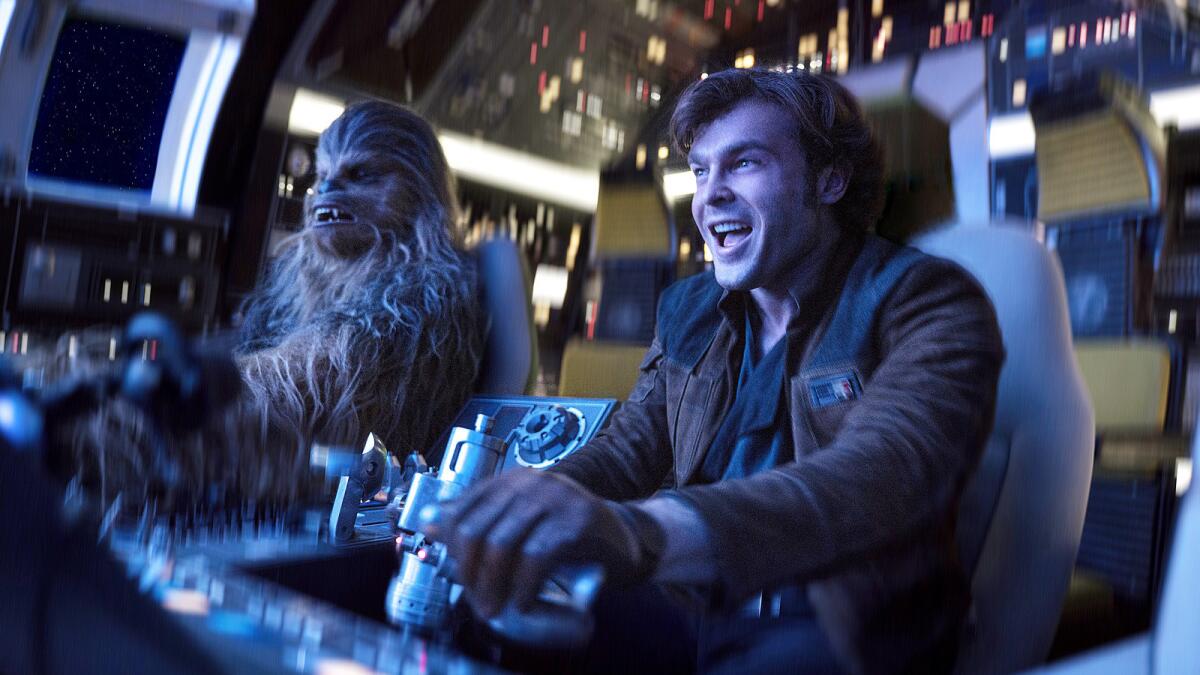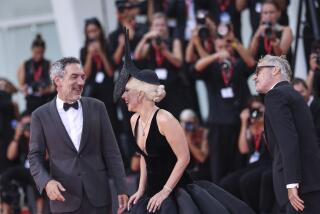Q&A: How ‘Solo’s’ visual effects team pulled off the Millennium Falcon’s famed 12-parsec Kessel Run

The thing about the Millennium Falcon is she’s full of surprises. No one understood that better than the cast of “Solo: A Star Wars Story” once they stepped in to the cockpit of the fastest hunk of junk in the galaxy on the stages of London’s Pinewood Studios. They were going to rehearse a scene in which the ship, flown by Lando Calrissian (Donald Glover) and his droid co-pilot L3-37 (Phoebe Waller-Bridge), makes the jump to hyperspace.
The cockpit was resting atop a hydraulic gimbal that could spin the set 360 degrees if needed, and it was surrounded by enormous LED screens standing 50 feet tall onto which were projected the same visuals moviegoers would later see in theaters.
“They got in the cockpit and ran through the first rehearsal,” recalls “Solo” visual effects supervisor Rob Bredow, who also serves as senior VP, executive creative director and head of visual effects company Industrial Light & Magic. “When Donald Glover and Phoebe Waller-Bridge grabbed the hyperspace levers, we cued the hyperspace [lines of stars on the screens], and the special effects team hydraulically shook the cockpit. The cast, they freaked out. They yelled and screamed and were laughing, ‘We actually went into hyperspace! This thing is real.’”
The day after receiving an Oscar nomination for his work on the movie — which chronicles the life of young Han Solo as played by Alden Ehrenreich — Bredow told The Envelope about his approach to the film and one of its most important sequences, the Kessel Run, in which Han and company smuggle an explosive cargo through a dangerous stretch of space.
You tackled a vital part of Han Solo lore here. He’s introduced in “Star Wars” bragging about having made the Kessel Run in less than 12 parsecs. Was that a lot of pressure?
We knew it was going to be a big challenge to make it spectacular and fun. What we did, instead of setting up a blue screen around the cockpit as we’ve done many times in the past, we used a rear-projection screen that was wrapped around the cockpit 180 degrees. On that screen, we had five projectors showing really high-resolution media that Industrial Light & Magic had created. So when the actors were sitting in the cockpit, they actually saw the Kessel Run happening in front of them live. Bradford Young, our director of photography, used the screen as the primary lighting source for that sequence, so you get this amazing integration between the actors and the world that they’re in. It brings a real visceral feel to that sequence. We had a bunch of shots where what we saw on set was exactly what we put in the movie.
How much front-end work did that require to have that imagery ready to go prior to filming?
Industrial Light & Magic had to generate 20 minutes of full-quality finished visual effects before we even shot a second of footage. Those shots were done at a very high resolution, 8K, so even higher resolution than we would have to do for the highest-quality movie theater because of the way the screen wrapped around. It was like doing a 20-minute-long simulator ride like you’d go on at Disneyland before we had even started shooting. We also built 120-130 cues throughout that Kessel Run, so it wasn’t like you’d press play and it would play for 20 minutes. We had all sorts of looping moments and interactive elements that we could change in real time to address [director] Ron Howard’s ideas or to backlight the characters in a certain way if Bradford Young had notes. We could interactively respond to the demands on set in a real-time way. It was super fun to be doing special effects live on set on a “Star Wars” movie, but it did require a lot of work in advance of the shoot.
The Falcon takes so much abuse in that sequence. How did you go about showcasing its transformation?
One of our favorite projects was to figure out how to go from Lando’s Falcon — this glossy, clean, pristine Falcon that we’ve never seen before — and slowly transform this ship over the course of the Kessel Run into something much closer to the Falcon that we know and love. The design was led by [VFX art director] James Clyne. He sent out kind of a road map — when this asteroid hits this part, we’ll knock this component off. We worked our way through the destruction of the layers of shielding on the outside of the Millennium Falcon, so we could slowly reveal what we called Han’s Falcon. I think we had over a dozen Millennium Falcon models that we were swapping in from shot to shot and keeping track of the continuity throughout the Kessel Run.
More to Read
From the Oscars to the Emmys.
Get the Envelope newsletter for exclusive awards season coverage, behind-the-scenes stories from the Envelope podcast and columnist Glenn Whipp’s must-read analysis.
You may occasionally receive promotional content from the Los Angeles Times.










